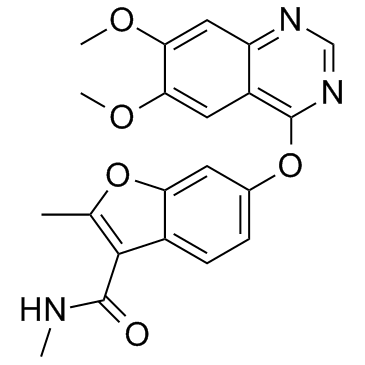1194506-26-7
| Name | 6-(6,7-dimethoxyquinazolin-4-yloxy)-N,2-dimethylbenzofuran-3-carboxamide |
|---|---|
| Synonyms |
3-Benzofurancarboxamide, 6-[(6,7-dimethoxy-4-quinazolinyl)oxy]-N,2-dimethyl-
6-[(6,7-Dimethoxy-4-quinazolinyl)oxy]-N,2-dimethyl-1-benzofuran-3-carboxamide 6-[(6,7-dimethoxy-4-quinazolinyl)oxy]-2-methyl-benzofuran-3-carboxamide HMPL-013 |
| Description | Fruquintinib (HMPL-013) is a highly potent and selective VEGFR 1/2/3 inhibitor with IC50s of 33, 0.35, and 35 nM, respectively. |
|---|---|
| Related Catalog | |
| Target |
VEGFR1:33 nM (IC50) VEGFR2:35 nM (IC50) VEGFR3:0.5 nM (IC50) |
| In Vitro | Fruquintinib demonstrates potent inhibition on VEGF-A dependent KDR phosphorylation in HEK293-KDR cells and VEGF-A induced proliferation in primary HUVECs with IC50s of 0.6±0.2 nM and 1.7 nM, respectively. Similarly, potent VEGFR3 attenuation by fruquintinib is observed in primary HLECs, with IC50s of 1.5 nM and 4.2 nM for VEGF-C stimulated VEGFR3 phosphorylation and proliferation, respectively. Fruquintinib suppresses the tube branching, tube length and area in a concentration-dependent manner. The tubule length of primary HUVECs decreased by 74% and 94% at 0.03 and 0.3 μM of fruquintinib, respectively. Fruquintinib inhibits HUVEC tubule growth and CAM angiogenesis. Tube formation is suppressed significantly after treatment with fruquintinib at 0.3 μM for 18 hours[1]. |
| In Vivo | Gastric cancer BGC-823 model is found to be most sensitive to fruquintinib. In this model, fruquintinib inhibits tumor growth by 62.3% and 95.4∼98.6%, at 0.5 and 2 mg/kg once daily dosing, respectively. When the dose is elevated to 5 mg/kg and 20 mg/kg, the tumors regress by 24.1% and 48.6%, respectively. The level of anti-tumor growth activity of fruquintinib varies in different tumor xenograft models. Fruquintinib significantly decreases the micro-vessel density even at the lowest dose of 0.8 mg/kg[1]. |
| Cell Assay | Primary HUVECs or HLECs in exponential phase are suspended in 100 μL of RPMI-1640 media containing 0.5% FBS, and seeded at 5000 cell/well in 96-well plates pre-coated with 0.2% gelatin or fibronectin, and incubated overnight in a 5% CO2, 37°C incubator. Fruquintinib and VEGF-A165 or VEGF-C (50 ng/mL) are added and incubated for 48 hours. Viability of the cells is determined using CCK-8 assay format[1]. |
| Animal Admin | Mice: The patient derived xenograft models are established after the primary tumor adopted serial passages in vivo. Once tumors have grown to 100-300 mm3, the animals are randomly assigned with 6-8 animals per group. The mice are treated orally with the vehicle (control group) or fruquintinib at a dose range of 0.5-20 mg/kg suspended in the vehicle (treated group) once daily for 3 weeks. In combination studies, docetaxel (Taxotere, 5 mg/kg) or oxaliplatin (10 mg/kg) is administered to nude mouse via intravenous injection, once a week. Tumor size and body weights are measured 3 times a week. Tumor volumes (TV) are calculated[1]. |
| References |
| Density | 1.3±0.1 g/cm3 |
|---|---|
| Boiling Point | 600.5±55.0 °C at 760 mmHg |
| Molecular Formula | C21H19N3O5 |
| Molecular Weight | 393.393 |
| Flash Point | 317.0±31.5 °C |
| Exact Mass | 393.132477 |
| PSA | 95.71000 |
| LogP | 3.08 |
| Vapour Pressure | 0.0±1.7 mmHg at 25°C |
| Index of Refraction | 1.639 |
| Storage condition | -20°C |
